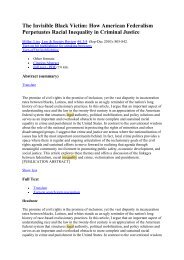Ski – resort and regional development: profile of visitors ... - E-Journal
Ski – resort and regional development: profile of visitors ... - E-Journal
Ski – resort and regional development: profile of visitors ... - E-Journal
You also want an ePaper? Increase the reach of your titles
YUMPU automatically turns print PDFs into web optimized ePapers that Google loves.
Measuring destination competitiveness: an exploratory study <strong>of</strong> the canaries, mainl<strong>and</strong> spain, france, the balearics <strong>and</strong> italy<br />
valid. Although the size <strong>of</strong> the sample group is small, it is not far different from other surveys<br />
used in other reference studies, like those cited in Kozak <strong>and</strong> Rimmington (1999) (n = 294)<br />
<strong>and</strong> Yoon <strong>and</strong> Uysal (2005) (n = 148). It should be highlighted that this was only a pilot study<br />
carried out during the low season. Furthermore, since it was a pilot study, the questionnaires<br />
were available in English <strong>and</strong> Spanish.<br />
The questionnaire was divided into two different sections, <strong>and</strong> headed by a series <strong>of</strong> preliminary<br />
questions. In this introductory part, the interviewees was asked whether they were a citizen<br />
<strong>of</strong> the European Union, whether they had spent this current stay on holiday in the Balearics,<br />
<strong>and</strong> whether they had been to mainl<strong>and</strong> Spain, the Canaries, France or Italy on holiday during<br />
the last two summers (2004 <strong>and</strong> 2005). Only if the interviewees answered yes to all three<br />
questions did the interviewer proceed to conduct the main body <strong>of</strong> the survey.<br />
The first part <strong>of</strong> the interview contained <strong>pr<strong>of</strong>ile</strong>-type questions, enquiring about the interviewees’<br />
country <strong>of</strong> residence, sex <strong>and</strong> age, the type <strong>of</strong> holiday they had booked, length <strong>of</strong> stay at the<br />
destination etc.<br />
In the second part, the tourists were asked to rate possible motivations that might have prompted<br />
them to choose their holiday destinations during the last two summers. Using a scale that<br />
ranged from 1 (“not at all important”) to 5 (“very important”), the tourists were asked to<br />
indicate how important certain motivations were in persuading them to visit the said destinations.<br />
A list <strong>of</strong> motivations or destination “attractors” was carefully drawn up, using various conceptual<br />
studies <strong>of</strong> destination attractors (Crouch <strong>and</strong> Ritchie, 1999; Dwyer <strong>and</strong> Kim, 2003) <strong>and</strong><br />
different empirical studies in other destinations (Kozak <strong>and</strong> Rimmington, 1999; Enright <strong>and</strong><br />
Newton, 2004; Yoon <strong>and</strong> Uysal, 2005; Kim et al., 2000). Likewise, the annual Tourist<br />
Expenditure Surveys that are conducted by the <strong>regional</strong> governments <strong>of</strong> the Balearic Isl<strong>and</strong>s<br />
(Govern de les Illes Balears, 2001) <strong>and</strong> Canary Isl<strong>and</strong>s (Gobierno de Canarias, 2005) were<br />
also used. These contain a list <strong>of</strong> key travel motivations for visits to both archipelagos. Finally,<br />
a workshop was held with three lecturers who specialize in tourism studies at the University<br />
<strong>of</strong> the Balearic Isl<strong>and</strong>s. As a result <strong>of</strong> all the above, 24 travel motivations or attractors were<br />
selected.<br />
Lastly, the interviewees were asked to rate their level <strong>of</strong> satisfaction with each <strong>of</strong> the above<br />
factors at each <strong>of</strong> the destinations they had visited over the last few years. Using a scale from<br />
one to five, ranging from 5 (“very satisfied”) to 1 (“not at all satisfied”), the tourists were<br />
asked to choose a value for each attractor at each destination. They were also given the<br />
opportunity to leave a blank space if they did not have enough information at their disposal<br />
to assess a particular factor (particularly in the case <strong>of</strong> motivations associated with certain<br />
market segments, such as the “existence <strong>of</strong> facilities for the elderly <strong>and</strong>/or children” or<br />
“nightlife” ).<br />
Tourism Today - Fall 2007 - Full Paper<br />
67














